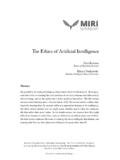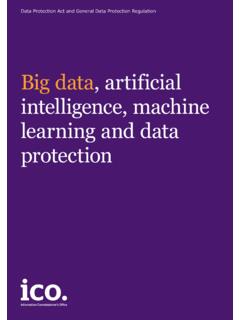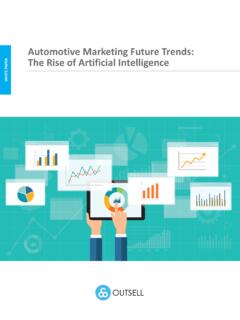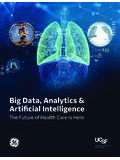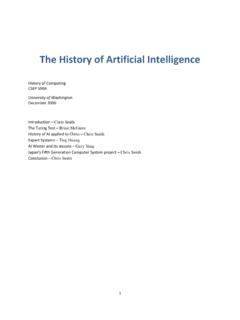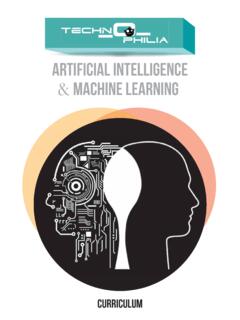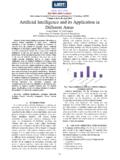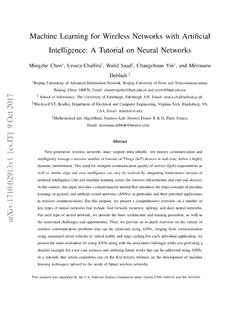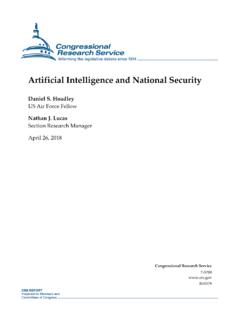Transcription of Artificial Intelligence in Business - pega.com
1 BuildforChangeA PEGA WHITEPAPERDr. Rob F. Walker,Vice President, Decision Management and Analytics, PegasystemsArtificial Intelligence in Business : Balancing Risk and technology is evolving faster than expected and is already surpassing human decision-making in certain instances. And sometimes, in ways we can t explain. While many are alarmed by this, AI is producing some of the most effective and dramatic results in Business today. But there is a downside. Using uncontrolled AI for certain Business functions may cause regulatory and ethical issues that could lead to liability. Optimizing AI for maximum benefit requires a new approach. This paper will consider recent advances in AI and examine how to balance safety with effectiveness through judicious control over when to use transparent vs. opaque AI. May 2017, Ke Jie, the world s best player of the ancient Chinese board game Go, pictured in Figure 1a, was defeated in three straight games.
2 This is important because he was defeated by AlphaGo, an AI computer program developed by Google DeepMind. DeepMind has since retired AlphaGo to pursue bigger AI challenges. It s anybody s guess what they ll do next, as just a year earlier their Go victory wasn t thought possible. Winning at Go requires creativity and intuition that in 2016 were believed out of reach for today s technology. At that time, most experts thought it would be 5-10 years before computers would beat human Go champions. While this is one of the most technologically impressive achievements for AI to date, there have been other recent advancements that the general public might find equally surprising. Composer David Cope has been using his AI: a match for human creativity?Experiments in Musical Intelligence (EMMY) software to fool music critics into believing they were hearing undiscovered works by the world s great composers for the past 20 years.
3 His most recent achievement is a new Vivaldi, whose works were previously thought too complex to be mimicked by software. And in 2016, an AI learned how to counterfeit a Rembrandt painting based on an analysis of the Dutch master s existing body of work. The results are shown in Figure it might not fool art critics, it would likely fool many art lovers and conveys to the less-trained eye much of the same aesthetic and emotional complexity of an original Rembrandt. The point of these examples is that AI, at least in discrete areas, is already regularly passing the Turing Test, a key milestone in the evolution of AI. Visionary computer scientist Alan Turing, considered by many to be the father of AI, posited the test in 1a: Ke Jie defeated by AlphaGoFigure 1b: AI-generated Turing (1912-1954) understood as early as the 1940s that there would be endless debate about the difference between Artificial Intelligence and original Intelligence .
4 He realized that asking whether a machine could think was the wrong question. The right question is: Can machines do what we (as thinking entities) can do? And if the answer is yes, isn t the distinction between Artificial and original Intelligence essentially meaningless? To drive the point home, he devised a version of what we today call the Turing Test. In it, a jury asks questions of a computer. The role of the computer is to make a significant proportion of the jury believe, through its answers to the questions, that it s actually a human. The Turing TestIn light of Turing s logic, what effectively is the difference between an AI being able to counterfeit a Rembrandt painting and it being a painter? Or being able to compose a new Vivaldi symphony and it being a composer? If an AI can pretend at this level all the time, under any circumstance, no matter how deeply it is probed, then maybe it actually is an artist, or a composer, or whatever else it has been taught to be.
5 In any case, as Alan Turing would say, how could we possibly prove otherwise? Can machines do what we (as thinking entities) can do? would it take for an AI to convince a Turing Test jury that it is a human? This would certainly require much more than just being able to paint, or compose music, or win at Go. The AI would have to be able to connect with the jury members on a human level by exhibiting characteristics of human emotional Intelligence , such as empathy. Based on the examples above, perhaps it s no surprise that Al can model and mimic the human psychological trait of empathy. Case in point: Pepper. Pepper (shown in Figure 2) is a roughly human-shaped robot that specializes in empathy. Pepper was created by Softbank Robotics, a Japanese company, that markets Pepper as a genuine day-to-day companion, whose number one quality is its ability to perceive emotion. Softbank designed Pepper to communicate with people in a natural and intuitive way, and adapt its own behavior to the mood of its human companion.
6 Pepper is used in Softbank mobile stores to welcome, inform and amuse their customers. Pepper has recently also been adopted into a number of Japanese Turing Test for emotionFigure 2: Pepper the of Pepper s empathic abilities can be seen in Figure 3. Don t look at the robot; look at the girl next to it. Look at her face, specifically her eyes. That is real emotion. She s excited to have connected, on what feels like a human level, with her new friend 4 shows representations of the mental maps, maps, or hierarchies of emotions, Pepper uses to analyze and respond to the emotions of others. In theory, Pepper s successors will contain mental maps that are arbitrarily deep and complex. And at some point, whether you call it pretend or not, their emotional responses will pass a Turing Test as 3: Pepper posing with a fanFigure 4: Pepper s Mental MapsAt , consider Sophia seen in Figure 5.
7 Designed to resemble Audrey Hepburn, Sophia is what her creator Dr. David Hanson calls an evolving genius machine . According to him, she and Dr. Hanson s other robots have the potential to become smarter than humans and to learn creativity, empathy and compassion. Sophia has become a media darling and given a number of high-profile interviews. In those interviews, she offers convincingly human answers to the thought-provoking questions tossed her way. The YouTube video Sophia Awakens shows just how human-like machines are becoming. It s beginning to appear that we no longer need to worry about a robot passing the Turing Test, we need to worry about it pretending to fail. In March 2016, AI researcher Stuart Russell stated that AI methods are progressing much faster than expected, (which) makes the question of the long-term outcome more urgent, adding that in order to ensure that increasingly powerful AI systems remain completely under human there is a lot of work to do.
8 Figure 5: David Hanson s be dragonsBuilding on Mr. Russel s sentiments, some have posited that the long-term outcomes of AI and other advanced technologies are extremely dangerous. SpaceX founder Elon Musk is on record as saying that Artificial Intelligence is humanity s biggest existential threat. And he has a kindred spirit in Sun Microsystems co-founder Bill Joy, who in 2000 wrote a manifesto entitled Why the Future Doesn t Need Us. In it, he examined the potential threats posed by three powerful 21st century technologies biotech, nanotech, and AI: The 21st-century technologies - genetics, nanotechnology, and robotics (GNR) - are so powerful that they can spawn whole new classes of accidents and abuses. Most Knowledge alone will enable the use of them. Thus, we have the possibility not just of weapons of mass destruction but of knowledge-enabled mass destruction (KMD), this destructiveness hugely amplified by the power of self-replication.
9 Despite such warnings, development in each of these areas has continued unabated. And the advances made thus far are truly spectacular. In biotech, one of the things Bill Joy warns against is tinkering with DNA. He proposes government restraints on the practice. Yet, scientists from Harvard and MIT have developed a search and replace genetic editing technique called CRISPR-Cas9 that makes modifying the DNA of humans, other animals, and plants much faster and easier than ever before. According to Science magazine, The CRISPR-Cas9 system is revolutionizing genomic engineering and equipping scientists with the ability to precisely modify the DNA of essentially any organism. While arguably not as advanced as biotech, a nanotech discovery received the Nobel Prize for science in 2016. A trio of European scientists developed the world s smallest machines. Scientists use these nano-machines to create medical micro-robots and self-healing materials that repair themselves without human intervention.
10 This must send a shudder down Bill Joy s spine, as he fears that nanobots will eventually escape our control, begin to replicate rapidly and, in one example, spread like blowing pollen and reduce the biosphere to dust in a matter of days. This has become known among nanotechnology cognoscenti as the gray goo problem. A rather ignominious end to human endeavor AI, Mr. Joy s main concern is that we aspire to achieve a utopian future of leisure, and ultimately immortality, by gradually replacing our physical bodies and consciousness with robotic technology. So, what s the catch? Specifically, Musk s fear, that humanity will not survive such a close encounter with what will by then be a superior species. Joy asks, If we are downloaded into our technology, what are the chances that we will thereafter be ourselves or even human? In this case, the coup might be bloodless (not a Terminator-esque annihilation), but humanity as we know it might disappear nonetheless.
